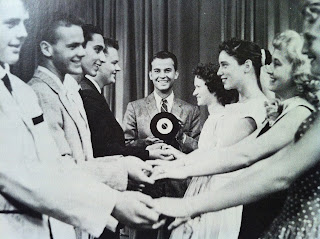Era 60an. Era rock'n'roll. Eranya anak muda. Eranya ekonomi remaja. Semua barang dibuat semurah mungkin, se-portable mungkin, sedinamis mungkin. Salah satunya adalah radio transistor. Sejak dimulainya produksi radio transistor di tahun 1954, orang bisa menikmati hiburan lagu di mana pun. Seperti yang ditulis di artikel majalah LIFE tahun 1960 tentang transistor craze:
Who listens to all these radios? First, as everybody knows, teeners and sub-teeners who buy the litte sets by the millions with their lunch money. Hooked on sound, they wander abroad with little plastic objects like first-aid kits looped in their belts.Jaman itu, ngga nenteng radio transistor ngga gaul. Lebih lanjut:
They have even been seen dancing in public squares each with a transistor cradled on the other's shoulder, tuned in to the same station.Seru! Dan budaya mendengar radio tidak lagi di ruang keluarga dengan satu set besar. Yang sibuk bekerja kini bisa ditemani radio saat nglembur, lagi mancing di tengah danau tetap bisa memantau siaran langsung sepak bola.
In the sixties every teenager had to have a transistor radio. They were just like mobile phones are today - cheap, colourful and highly desirable. You could have music and news on the move. (source)Memiliki radio transistor di awal 60an dianggap gadget gaul utama anak muda seperti menenteng Sony Walkman di 80an, menenteng CD player di 90an atau mengantongi iPod di awal 2000an.
They were the passport to the modern world and showed that you were part of the "with it" generation. People in Third World countries would save hard to get one. Quality was often low, but you could not be part of the Swinging Sixties without one. (source)Portable entertainment seperti ini yang membuat remaja saat itu dekat dengan DJ stasiun radio. Saat DJ pamit siaran, usai sudah hiburan setia setiap saat. DJ atau deejay menjadi perantara komunikasi di kalangan remaja, messenger dan fasilitator seperti yang ditulis oleh Jane & Michael Stern di buku Sixties People:
Radio was the way teens knew what was going on. They communicated with each other by calling in record dedications and liestened closely for the deejay to say "This is going out to Bobby for Vonetta, who wants her lover boy to know.. 'There's a Moon Out Tonight.'"

Dick Clark, deejay radio yang kemudian jadi selebriti dan membawa acara TV (dari buku Sixties People oleh Jane & Michael Stern)
Saking hit-nya, deejay radio jadi semacam social hub dan didamba seperti layaknya selebriti. Sedemikian dekatnya deejay dengan pendengar remaja, lahirlah istilah-istilah slank di antara mereka agar tidak dipahami oleh orang tua atau keluarga mereka. Lebih lanjut Jane & Michael Stern menulis:
Listening to the radio was no longer a family affair. Teens could tune in while in their rooms supposedly doing homework or in the corridors of school. Any teen able to scrape together $16.50 for the cheapest two-by-four inch Silvertone had the power to secede from the adult world at any time.Mirip dengan internet & social network sekarang, remaja punya 'ruang gaul' sendiri. Bedanya, dulu perantaranya radio & deejay, sekarang berangsur beralih ke Facebook atau Twitter. Dulu device di kantong radio transistor, sekarang smartphone.
Related products:
- Zenith Royal 500B
- RCA Victor 1TP2
- GE P1730

Sampai sekarang dj radio masih punya tempat di pendengar setianya
ReplyDeleteBener. Dulu diawali di tahun 60an saat remaja punya akses ke stasiun radio dng radio transistor mereka.
Delete